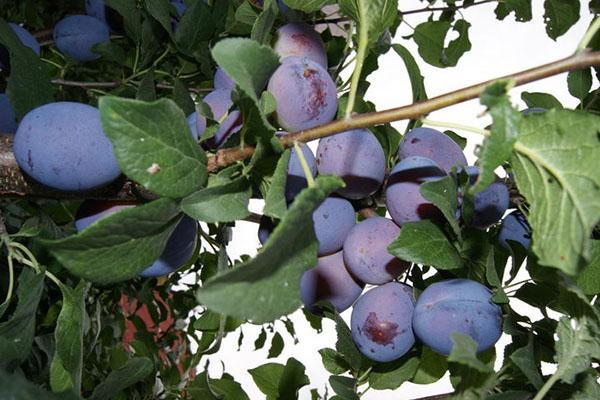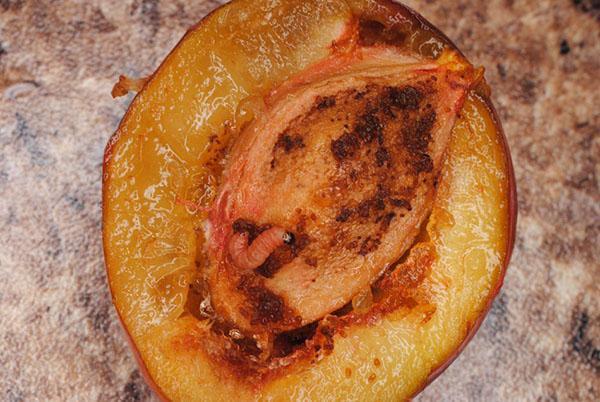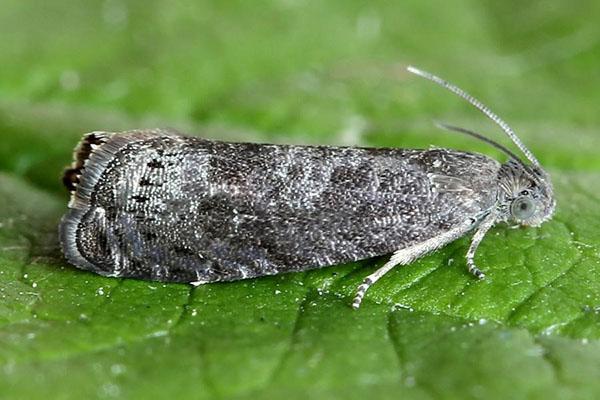Photos with descriptions will help in the fight against pests of plums
 Fruit trees, including plums, attract the attention of a wide variety of insects. Descriptions of what plum pests look like and the fight against them, photos of possible enemies and a schedule of necessary measures will help the gardener be fully armed and save the harvest.
Fruit trees, including plums, attract the attention of a wide variety of insects. Descriptions of what plum pests look like and the fight against them, photos of possible enemies and a schedule of necessary measures will help the gardener be fully armed and save the harvest.
Plum moth

Eggs laid on flower buds and buds, turning into pinkish-red caterpillars, move inside the ovary and grow, feeding on the pulp of a ripening plum. As a result, the ground under the tree is dotted with unripe fruits, and those that have time to fill up are spoiled inside by a gluttonous pest.
The crop spoiled by the plum moth is much worse in quality, is not stored and is practically suitable for culinary processing.
The caterpillars that have left the fruits winter in the crevices of the bark, and in June they turn into a new generation of butterflies.
 Although only caterpillars bring tangible harm, the fight against the plum pest, in the photo, is carried out comprehensively and throughout the warm season:
Although only caterpillars bring tangible harm, the fight against the plum pest, in the photo, is carried out comprehensively and throughout the warm season:
- In early spring and at the green cone stage, trees are treated with insecticides.
- From a vein and before the onset of cold weather, the trunks are regularly cleaned and loosened. Weeds are removed and root growth is cut out.
- To prevent the caterpillars from wintering comfortably, they carry out sanitary pruning, clean the dead bark, and whitewash the stems.
- The fallen ovary is collected and burned.
If the presence of pests is detected when the plums are already being poured, protective equipment must be applied extremely carefully, referring to the instructions and the decay time of the active chemical.
Ringed and gypsy moth
 Caterpillars of these species of moths eagerly destroy foliage, inflorescences and buds. With a massive appearance of a pest, the damage from it can be devastating. Therefore, the fight begins in advance, when the butterflies lay their eggs, or in early spring before the leaves bloom, until the caterpillars themselves appear.
Caterpillars of these species of moths eagerly destroy foliage, inflorescences and buds. With a massive appearance of a pest, the damage from it can be devastating. Therefore, the fight begins in advance, when the butterflies lay their eggs, or in early spring before the leaves bloom, until the caterpillars themselves appear.
 From the second half of summer, caterpillars turn into pupae, hiding in cracks in the bark or in drying, rolled leaves. To prevent the spring spread of the plum pest shown in the photo, to simplify the fight against it will help:
From the second half of summer, caterpillars turn into pupae, hiding in cracks in the bark or in drying, rolled leaves. To prevent the spring spread of the plum pest shown in the photo, to simplify the fight against it will help:
- collection and destruction of fallen leaves;
- trunk sanitization and branch pruning;
- manual collection of spider nests with caterpillars;
- destruction of eggs;
- large-scale processing of fruit trees with plant and chemical preparations.
Plum thickened
 An inconspicuous winged insect, no more than a centimeter long, does not give the impression of a formidable enemy of the plum, but its 5-millimeter white larvae can cause a significant decrease in yield.
An inconspicuous winged insect, no more than a centimeter long, does not give the impression of a formidable enemy of the plum, but its 5-millimeter white larvae can cause a significant decrease in yield.
The female lays eggs in a newly formed ovary, after which the larva actively grows inside the bone, feeding on it and causing the immature fruits to fall off closer to the middle of summer. If the carrion is left under a tree, the plum stump will win out well. And with the beginning of flowering in the spring, the years of young insects ready to lay eggs will begin.
 For the prevention of an attack, the fallen ovary is destroyed, and as an effective method of control, plum processing is used after flowering, 7-10 days after the petals fall.For the rest, the prevention and control of this plum pest has no peculiarities.
For the prevention of an attack, the fallen ovary is destroyed, and as an effective method of control, plum processing is used after flowering, 7-10 days after the petals fall.For the rest, the prevention and control of this plum pest has no peculiarities.
Plum shield: methods of struggle
 When faced with a scabbard or false shield, novice gardeners often cannot identify these pests in time, mistaking dangerous insects for frozen drops of gum or growths on the bark.
When faced with a scabbard or false shield, novice gardeners often cannot identify these pests in time, mistaking dangerous insects for frozen drops of gum or growths on the bark.
The fact is that both species are distinguished by low mobility and excellent camouflage. Sucking on young shoots and leaf stalks, scale insects literally grow into the surface and harm, actively feeding on plant juices. Only males and young individuals can move.
With a massive defeat of plums, especially the still immature seedlings weaken, their foliage dries and falls off, and sometimes the trees lose fruit and even die. If you do not take all measures to combat the shield on the drain in time, the situation becomes more complicated. The pest multiplies rapidly and develops a sticky honeydew, on which a sooty fungus willingly settles, which makes breathing difficult and interferes with growth.
 In contrast to the scabbard with a flattened shield, the false shield is more like a hemisphere. Moreover, it does not grow together with the bark, that is, it can be separated mechanically, and does not emit dew dew.
In contrast to the scabbard with a flattened shield, the false shield is more like a hemisphere. Moreover, it does not grow together with the bark, that is, it can be separated mechanically, and does not emit dew dew.
Measures to combat false shield on the drain differ little from those that are taken when infected with shield. Insects should be removed with a brush and treated with a solution based on kerosene and laundry soap or soap and alcohol.
If large areas are covered with pests, and home methods do not help, turn to chemical remedies, carrying out several treatments from the scale insect at weekly intervals.
Plum aphid
 Green plum aphid refers to sucking pests that weaken plants and slow down tree growth. First of all, insects settle on young foliage and new, not lignified shoots, creating a silvery-green swarming layer. The fight against the plum pest, as in the photo, is complicated by:
Green plum aphid refers to sucking pests that weaken plants and slow down tree growth. First of all, insects settle on young foliage and new, not lignified shoots, creating a silvery-green swarming layer. The fight against the plum pest, as in the photo, is complicated by:
- speedy reproduction;
- the ability of females to fly from tree to tree;
- spreading aphids by ants.
In order to prevent loss of yield, in spring and autumn, the crown is trimmed, root shoots and fattening shoots are regularly removed, and trapping belts are installed and the trunks of fruit trees are whitened.
Insecticides also play a significant role. However, it is better to process plums from aphids after flowering with the help of natural preparations based on tobacco or soap infusion, mustard water or decoction of tomato tops.
Black and yellow plum sawfly
 All cultural plum varieties prone to damage by plum sawfly. Insect larvae cause harm, damaging leaf plates and ovary.
All cultural plum varieties prone to damage by plum sawfly. Insect larvae cause harm, damaging leaf plates and ovary.
The black sawfly is activated during the swelling phase of the buds. In an unopened flower, an adult female lays eggs, which turn into larvae. In the early stages of development, the pest feeds on the pulp of the ovary, and then infects the leaves, literally turning them into openwork skeletons devoid of greenery.
 The yellow plum sawfly, except for the plum itself, does not disdain other types of stone fruit crops. Traces of insect activity are visible on leaves and fruits. If you do not take urgent measures and do not engage in prevention, the defeat will be massive.
The yellow plum sawfly, except for the plum itself, does not disdain other types of stone fruit crops. Traces of insect activity are visible on leaves and fruits. If you do not take urgent measures and do not engage in prevention, the defeat will be massive.
As a preventive measure, loosening of the soil around the trunk is used under the entire crown of the tree. It is especially important not to neglect this in early spring and before the onset of cold weather. Before flowering begins, in addition to spraying with insecticides, mechanical removal of pests, which are shaken off onto a spread canvas or non-woven material, will help. In summer, it is necessary to mercilessly remove and destroy the affected fruits.